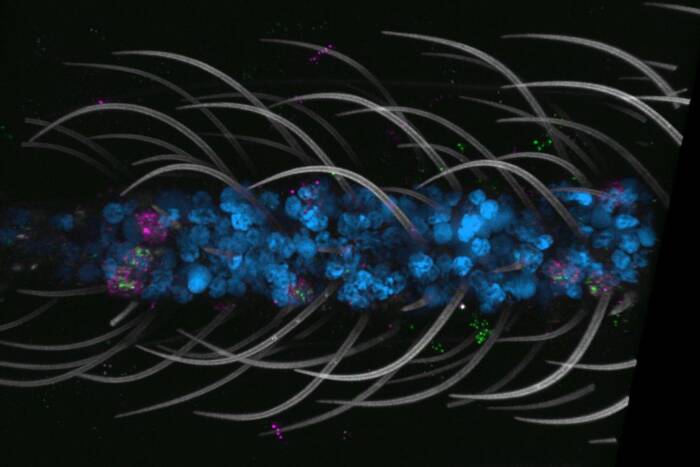New science of "epigenetics" advanced by findings reported in Molecular Cell
New science of “epigenetics” — which explores how physical characteristics of cells and their chromosomes can be inherited separate from the DNA sequence — is advanced by recent findings reported in Molecular Cell
Since Gregor Mendel first crossed strains of peas in his garden over 100 years ago, the word genetics has been used to describe how changing the DNA sequence of a gene can produce physical changes ranging from the color of tulips from pink to white to the conversion of healthy cells into cancer cells in the human body.
The mutations in the DNA code of genes responsible for the altered tulip color and body cells can be passed on to subsequent generations.
But scientists have known that some physical changes that are passed on to the next generation can’t be attributed to mutations in DNA alone. Thus a relatively new field of research — epigenetics — has emerged to investigate the inheritance of physical changes that cannot be traced back to mutations in the DNA sequence.
Epigenetic changes in the cells of humans and animals often result in the inactivation, or silencing, of a specific gene’s activity. Gene silencing is crucial for the survival of developing female humans and mammals, which carry two copies of the X chromosome (compared to males, who carry an X and a Y). A double dose of the genes carried in the X chromosome could be lethal, so gene silencing permanently inactivates one of the X chromosomes.
Rockefeller University’s C. David Allis, Ph.D., a leader in the field of epigenetics, and scientists at the University of Virginia now report that a major gene silencing “mark” in the nucleus of body cells is much more complex than previously thought. The “mark,” called histone methylation, is a chemical process that uses enzymes to attach a methyl chemical group to a specific amino acid, which is a building block of proteins. Specifically, this chemical modification occurs on the histone proteins, the small proteins required for the compaction of DNA within the cell’s nucleus.
In a research paper published in the December issue of Molecular Cell, Allis and colleagues, including first author Judd Rice, Ph.D., show that two separate enzymes are responsible for attaching methyl groups to the amino acid lysine. Importantly, these enzymes silence gene activity in different parts of the cell and with different degrees of permanence. Because these changes in gene activity take place away from DNA, scientists refer to them as epigenetic.
“There are certain conditions during which the cell will want a gene to be silenced permanently, and other times when a gene will be expressed only when it is needed, and then it will be switched off. It may make sense that some enzymes have evolved to permanently silence genes, and some enzymes have evolved to temporarily silence genes,” explains Allis, who is the Joy and Jack Fishman Professor and head of the Laboratory of Chromatin Biology at Rockefeller.
Allis and Rice focused on a lysine located at position 9 (Lys9) in the amino acid sequence of the “tail” of histone H3. The nuclei of human and animal cells contain four histone proteins – H2A, H2B, H3 and H4 – each of which has a long, flexible protein tail. Allis studies the chemical modifications to amino acids on the tails.
Allis and other researchers have suspected that the lysines in the histone tails could be modified to carry up to three methyl groups, but until now little evidence was available to support this theory.
In the Molecular Cell report, Allis and Rice show that an enzyme called SUV39 is solely responsible for the state of trimethylation of Lys9, while a second enzyme, G9a, regulates whether Lys9 is mono- or dimethylated.
“We still don’t understand the pathway of taking the cell from a monomethylated state to the trimethylated, but we do know that the enzyme G9a stops after Lys9 becomes dimethylated,” Allis says. “And it looks like SUV39 — by itself — can take the cell to the trimethylated state.”
Allis and Rice also found that trimethylated Lys9 is located in parts of the cell where gene activity is permanently silenced. Mono- and dimethylated Lys9, on the other hand, are located in parts of the cell where gene activity may be silenced temporarily.
The researchers used a novel panel of highly specific antibodies that could distinguish if Lys9 was singly, doubly or triply methylated.
Rice and Allis used these antibodies and a technique called immunofluorescence to visually identify the locations within the cell where mono-, di- and trimethylated Lys9 resides. These experiments pinpointed mono- and dimethylated Lys9 in silenced regions of euchromatin and trimethylated Lys9 in pericentric heterochromatin. Euchromatin refers to the genomic regions within a cell where gene activation or transcription typically occurs. Pericentric heterochromatin refers to an area near the centromere – the part on a chromosome that connects the two arms to form the characteristic “X” shape — where genes are usually always silenced.
As a final independent measure of their findings, the researchers used a technique called mass spectrometry to show that Lys9 can be singly, doubly or triply methylated in histone H3 isolated from human cells.
“Mass spectrometry can detect whether lysine 9 is mono-, di- or trimethylated based solely on the fact that we can measure the mass of one methyl group,” says Rice. “We were able to identify all three modifications and show that this is a naturally occurring process in human histones.”
In 2000, Allis, then at the University of Virginia, and Thomas Jenuwein at the Institute of Molecular Pathology in Vienna, Austria, showed SUV39 is an enzyme that attaches methyl chemical groups to Lys9. Jenuwein supplied antibodies to Allis for the research reported in Molecular Cell. Jenuwein’s laboratory at IMP reports on the methylation of Lys9 and Lys27 in the same issue of Molecular Cell.
“These findings reveal that there are additional layers of epigenetic gene regulation,” says Allis. “With respect to methylation as a major gene silencing mark, we now know that the cell has a trilogy of choices that we need to better understand.”
In addition to Allis and Rice, co-authors of the Molecular Cellpaper are Scott D. Briggs, Beatrix Ueberheide, Cynthia M. Barber, Jeffrey Shabanowitz and Donald F. Hunt at the University of Virginia, and Yoichi Shinkai at Kyoto University.
This research was supported by the National Institutes of Health.


